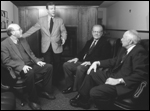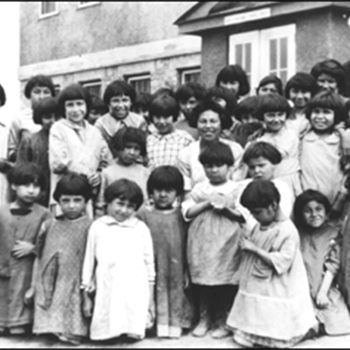 At an exposition held in the early years of the last century, more than 1,000 American automobile manufacturers exhibited their cars. Eighty years later that number is reduced to three (if Daimler-Chrysler is still considered an American company) but, more importantly, there is a standard navigational interface on every car operated worldwide (the British eccentricity of mounting the steering wheel on the right duly noted) that puts the accelerator and brake on the floor, activated by the right foot, the clutch—if there is one—by the left. There is no longer anyone alive who remembers seeing my wife’s great-aunt driving in and out of town from the rear of her car, steering with a tiller. The achievement of universal standards came only after fierce competition that eliminated entire countries from the industry, wrenched economies from their pre-industrial agrarianism, created a superhighway system that forever changed our concept of community, and led to acceptable collateral damage that includes an annual death toll of more than 50,000 people in the United States alone. (One rushes in where angels fear to tread when contemplating seminary survivorship a hundred years from now.)
At an exposition held in the early years of the last century, more than 1,000 American automobile manufacturers exhibited their cars. Eighty years later that number is reduced to three (if Daimler-Chrysler is still considered an American company) but, more importantly, there is a standard navigational interface on every car operated worldwide (the British eccentricity of mounting the steering wheel on the right duly noted) that puts the accelerator and brake on the floor, activated by the right foot, the clutch—if there is one—by the left. There is no longer anyone alive who remembers seeing my wife’s great-aunt driving in and out of town from the rear of her car, steering with a tiller. The achievement of universal standards came only after fierce competition that eliminated entire countries from the industry, wrenched economies from their pre-industrial agrarianism, created a superhighway system that forever changed our concept of community, and led to acceptable collateral damage that includes an annual death toll of more than 50,000 people in the United States alone. (One rushes in where angels fear to tread when contemplating seminary survivorship a hundred years from now.)
Fast-forward eighty years and edge onto the “information superhighway.” Our sense of community is altered yet again. In the year 2002, more than 60 percent of American households use the internet—far outstripping the percentage of households attending church each week—and they all do so using a common interface of simple commands that operate in the background connecting them to a worldwide web of information now so large as to be incalculable. It was not always so.
In fact, this year marks the tenth anniversary of the very creation of the World Wide Web: an accomplishment (rather than an event) that may well stand as the most important of the past millennium—gunpowder, movable type, the steam engine, telephone, powered flight, nuclear power and penicillin notwithstanding. This accomplishment—which now connects more than one-quarter of the world’s population—was the intellectual creation of a single individual whose inspired vision of collaboration has transformed the communication of the entire species. The story of the accomplishment reveals that it was an Englishman in Switzerland using an American software program to help European scientists exchange data that led to the creation of the World Wide Web. Even more extraordinary, the inspiration to organize information in random rather than hierarchical fashion came from a book titled Enquire Within Upon Everything: A Compendium of All Known Knowledge—a book in the author’s childhood home that had been published in 1858!
Unlike his contemporary, entrepreneur Bill Gates, who founded Microsoft and parlayed a tiny software operating system into a worldwide monopoly that made him the world’s richest man, physicist Tim Berners-Lee insisted from the start that the code for the Web be open to all and non-proprietary. Over the course of four years he gently but persistently shepherded the development process in both Europe and America and transformed software developers, scientists and academics into a loose band of contributors who could share his vision. The creation of the Web was not without struggle. There were plenty of technical obstacles to overcome, countless egos to assuage. But in keeping with the very nature of the collaborative effort involved, every chapter spills over with the names of those to whom Berners-Lee would give credit for the achievement.
As he puts it: “The blueprint for the new Web… has a social base, a technological plan, and some basic philosophy. In the very beginning I wrote the World Wide Web code, then went out into the world to promote the vision, made the technology freely available so people could start working on their little piece of it, and encouraged them.”
Faculty members, administrators and members of governing bodies who must rely on collaboration to achieve anything (and everything) will particularly appreciate Berners-Lee’s description of the challenge (and fun) of collaboration across continents, oceans and cultures. “Every now and again,” he writes,” the new systems go down, and we pay the price of being on the bleeding edge by having to wait ’til they are fixed. But we are gaining more of an understanding of what it will take to achieve the dream of collaboration through shared knowledge.”
For those who revel in the acquisition of special knowledge that gives them pride of place at cocktail hour, there is plenty of techno-wonk nitty-gritty about HTML, XML, SGML, and XHTML. There’s even an explanation of the pressures that led to the change in terms from the original “URI” (Universal Resource Indicator) to the now ubiquitous “URL” (Uniform Resource Locator) of more than passing interest when you discover Berners-Lee’s Universalist-Unitarian theology.
If you’d like an example of how a single individual’s vision of collaboration, borne on the shoulders of education and discipline, reinforced by naivete and persistence, can transform the world, this is worth the candle.
Berners-Lee is now director of the W3 Consortium at the Massachusetts Institute of Technology Laboratory for Computer Science. He was awarded a MacArthur fellowship in 1998.
Appetizer
A computer typically keeps information in rigid hierarchies and matrices, whereas the human mind has the special ability to link random bits of data. When I smell coffee, strong and stale, I may find myself again in a small room over a corner coffeehouse in Oxford. My brain makes a link, and instantly transports me there.
One day when I came home from high school, I found my father working on a speech….He was reading books on the brain, looking for clues about how to make a computer intuitive, able to complete connections as the brain did. We discussed the point; then my father went on to his speech and I went on to my homework. But the idea stayed with me that computers could become much more powerful if they could be programmed to link otherwise unconnected information.




























